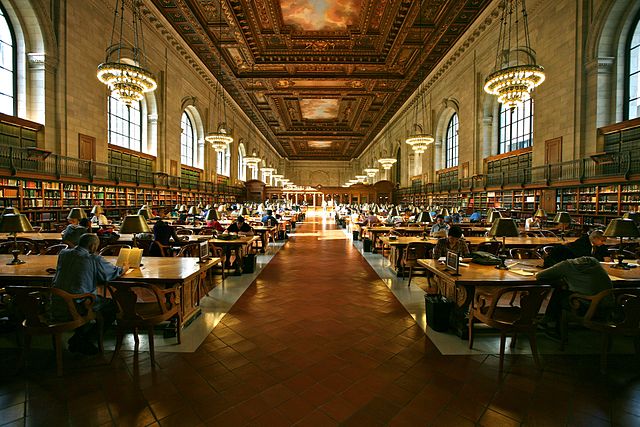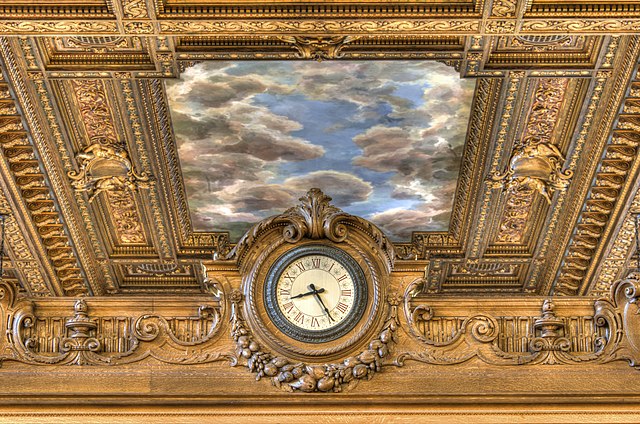New York Public Library
The New York Public Library (NYPL) system was founded in 1895, and now has over 90 branches, with a total collection of over 51 million items. It is the second largest public library in the United States, after the Library of Congress in Washington, D. C., and third largest in the world. Each year the NYPL is visited by 18 million readers, and its website is read on 32 million occasions by people from over 200 countries.
Building a collection
From its early years, the NYPL received good advice about what books and other items to acquire. The novelist Washington Irving, whose works are represented in the collection of the Thammasat University Library, served as President of the NYPL Board of Trustees. Irving had much influence on the new organization’s collecting policies. He was especially interested in new trends of thought in Europe, so from its first years, the library was not only concerned with what was being published in the United States. After Irving, the NYPL continued to get expert advice about acquisitions from a series of well-known authorities on different subjects, who were hired because of their knowledge. They all emphasized the importance of having a collection of the widest possible scope, involving literature and research from all over the world. The NYPL’s trustees in the 1800s worked to keep the library away from influence from politics and politicians.
Among the major purchases of books that they approved was the personal collection of Grand Duke Vladimir Alexandrovich of Russia, which was bought in 1931. The Grand Duke had a serious interest in artistic and intellectual matters, and had served as president of the Imperial Academy of Arts, Saint Petersburg, Russia. He also sponsored many painters, as well as the Imperial Russian Ballet.

Practical Knowledge
NYPL experts familiar with the rich documentary resources of the library have been called upon to help their homeland. During the Second World War, the NYPL’s chief of the Map Division was appointed as head of the geography section of the War Department’s New York Office of Military Intelligence. At a time of national crisis, the U.S. Army was able to reply on information from the NYPL’s map and book collections to provide thousands of rare maps that were not available from other sources to war agencies.
In 1911, the main branch of the New York Public Library was officially opened. Its collection by then was over one million volumes. Its marble design was much admired for its elegance. Two stone lions guarding the entrance became a familiar symbol of the NYPL.
The lions were named Patience and Fortitude in the 1930s during the Great Depression by New York Mayor Fiorello LaGuardia. Mayor LaGuardia felt that New Yorkers would require patience as well as fortitude, meaning courage, endurance, and strength of mind and character, to survive economic challenges. The lions have become the mascots of the NYPL, trademarked by the Library and they are represented in its logo.
Clearly there was much public need for the NYPL. During the first day it was open in 1911, an estimated crowd of up to 50,000 readers visited the new building. It remains an attraction for tourists, as well as students, researchers, and others.
As the library’s website explains,
The New York Public Library has been an essential provider of free books, information, ideas, and education for all New Yorkers for more than 100 years. Founded in 1895, NYPL is the nation’s largest public library system, featuring a unique combination of 88 neighborhood branches and four scholarly research centers, bringing together an extraordinary richness of resources and opportunities available to all. Serving more than 17 million patrons a year, and millions more online, the Library holds more than 55 million items, from books, e-books, and DVDs to renowned research collections used by scholars from around the world… Our local libraries play a key role in closing the digital divide, especially for the one in three New Yorkers who don’t have Internet access at home. New York City public school students rely on their local branches for homework help. The city’s immigrant communities count on NYPL’s English language and literacy classes. Job seekers depend on our comprehensive job search resources. Altogether, the Library offers 103,000 free programs annually, serving everyone from toddlers to teens to seniors. In the always expanding digital realm, The New York Public Library provides patrons worldwide with powerful online tools to help them discover its extensive resources and services. On nypl.org visitors can browse the Library’s immense collections, download e-books, and view more than 700,000 items from our award-winning Digital Collections. Through SimplyE, the Library’s new e-reader app, users can borrow instantly from NYPL’s entire collection of more than 300,000 free e-books in just a few easy steps. Through Ask NYPL our librarians are available to answer patron questions on any topic at any time. Supported by both public funds and private donations, The New York Public Library embarks on its next 100 years passionately committed to meeting the ever-changing needs of our patrons. For the millions who depend on us in this, the world’s most vibrant and diverse city, NYPL is more important than ever.

The library’s mission, as stated on its website:
NYPL’s Mission Statement
The mission of The New York Public Library is to inspire lifelong learning, advance knowledge, and strengthen our communities.
To deliver on this promise, we rely on three great resources—our staff, our collections, and our physical and digital spaces—to provide opportunities for learning and growth to all New Yorkers.
- We inspire lifelong learning by creating more able learners and researchers. We:
- Teach learning and information-navigation skills
- Provide tools, resources, and great places to work
- Engage in great exploratory conversations
- Ask and answer questions that encourage patrons to challenge their assumptions
- Support creativity, research, and problem-solving
- Bring people together to spark creative synergies and learn from each other
- We advance knowledge by providing free and open access to materials and information that reflect New York’s global perspective. We:
- Identify, acquire, and preserve items that enhance our unique areas of expertise
- Connect with other organizations whose materials complement our own
- Inspire interest, expand horizons, and enrich perspectives
- Build tools that allow us to connect with the world in our areas of expertise
- We strengthen our communities by promoting full citizenship and participation in society. We:
- Promote the development of key skills and capabilities
- Provide dynamic resources to help patrons understand and engage in society
- Create safe and reliable places where we and our patrons can enjoy, honor, celebrate, and engage with our communities
- Offer unique and authoritative materials of historical importance
- Bring our diverse communities together

(All images courtesy of Wikimedia Commons)

